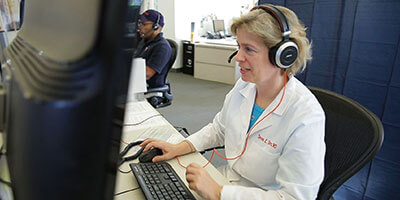The coronavirus pandemic is triggering a surge in telehealth, sometimes called telemedicine. If you didn’t know already, telehealth is medical care accessed remotely through the use of a smartphone, tablet, desktop or laptop computer. Global Rescue TotalCareSM provides access to telehealth resources at Elite Medical Group (EMG), delivered by board-certified physicians licensed in all 50 states.
Telehealth has been around for decades, but its use has recently exploded in response to the pandemic and social distancing protocol efforts. As more people come to rely on telehealth, more distinctions among the different telehealth providers have surfaced.
[Related reading: Five Reasons to Consider TotalCare]
For example, the concept of “continuity” of clinical care is an important component. Originally, continuity meant your hometown doctor knew you, your family, the medical histories and social circumstances and could factor it all into the determinants of care.
As health care became more expansive your primary care physician worked with other doctors, specialists like internists, cardiologists, dermatologists, ophthalmologists and ENTs.
Continuity became complicated, physicians had to collaborate as large teams to ensure everyone was working off the same, centralized information. To keep it all straight, positions like medical case workers and health care managers became career fields.
A New Model – Condensed and Centralized
The question now is how does telehealth fit into the current context of continuity in clinical care? One key is recognizing that the business model common for telehealth companies relies on a high volume of customers who are attended by several thousand doctors; this model of telehealth delivery can deliver basic service, according to Dr. Claudia Zegans, Medical Director at EMG.
“But the challenge to that, is if you’re someone who uses telehealth regularly, then you may never interact with the same provider,” she said.
Global Rescue TotalCare provides consumers with access to EMG’s telehealth services that are delivered using a completely different model, one that utilizes the centralized medical practice group at EMG, physician-colleagues who work together to care for patients, to provide the continuity of care one usually expects from traditional care environments.
“We’re a smaller group, so if someone is a regular user of TotalCare there is a good possibility that they will see the same physician they saw last time,” she said. “EMG doctors actively collaborate on cases so even if you don’t see the same doctor, the rest of us are briefed on your case and can access your record. People like that their story is already known and they don’t have to start from scratch every single time.”
The result is a personalized level of care unavailable from other telehealth providers.
Common Misconceptions
Part of the success of continuity in clinical care comes from patient disclosures. Some patients assume the provider conducting the telehealth consultation knows their story, is acquainted with all the medications they’re on, including those prescribed and obtained over-the-counter. They don’t. That’s a frequent misunderstanding. Revealing that information during the consultation is essential for an effective interaction.
Zegans said another misconception about telehealth is that a consultation equals a prescription.
“That’s not necessarily true. Telehealth is practiced with the same standards as an in-office visit.”
As telehealth resources are in higher demand, it’s important for people to understand that managing the insurance reimbursement component has been a barrier to patients utilizing it. To break through that obstacle, insurers have incorporated telehealth platforms into their offering so many people have access to it. But the fix often creates an unseen risk.
“The telehealth platform may not be integrated with the health care providers own health care facility, making continuity in clinical care unavailable,” she said. “We will integrate with a patient’s health care provider in any way they give us permission to do so. It’s quite flexible and customizable.”
Telehealth: It’s Not Just for Pandemics
Using telehealth reduces the need to go to the hospital, an urgent care facility or even a doctor’s office, where the risk of exposure to potentially infected individuals or surfaces is elevated. That can also result in dramatic cost savings since the average primary care visit costs $150 and the average emergency department visit can cost more than $1,000.
Depending on the telehealth service provider and various state regulations, your doctor can complete a video consultation and come to a medical assessment, write a prescription if medically appropriate and even order labs and imaging. Equally important, telehealth eases the burden on hospitals and urgent care facilities.
But a pandemic can lead to overwhelmed medical care centers, hospitals and doctor’s offices. Telehealth eases that pressure by providing virtual patient access to physicians for medical queries without unnecessarily crowding health facilities. It also prevents the patient from being exposed to potentially contagious COVID-19 patients during a hospital visit.
Dr. Zegans says physician consultations using video can not only lead to an appropriate diagnosis, but also assess how sick a person is and help determine who needs an in-person evaluation or specific testing at a medical facility.
“For others, telehealth is an effective way to address whatever their current medical concern is as much as possible without them ever leaving their home,” she said.
She added that the current pandemic has showcased telemedicine as incredibly useful in helping to decrease traffic at clinics, emergency departments and urgent care centers.
“This result is not only good for individual patients, but also for the entire community.”
Telehealth will remain an essential tool for travelers well after the pandemic abates. Based on a recent survey of Global Rescue members, who are among the most experienced travelers in the world, they want telehealth services when traveling outside of their home country by a 9-to-1 margin.
U.S. travelers want a medical perspective from their home country and they want access to an additional resource to the medical resources being provided abroad.
“I totally agree with that perspective. I see the power of oversight by U.S.-based physicians every single day,” Zegans said.
Coronavirus Concerns?
Are you a traveler worried about coronavirus? Getting sick or quarantined? Both can happen. Whether you’re at home, work, traveling now, or postponing a trip until later, you need to protect yourself. Obtaining access to telehealth services through a Global Rescue TotalCare membership is one important way travelers can get peace of mind.










